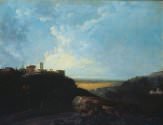Joseph Mallord William Turner
Joseph Mallord William Turner
Turner was born in 1775, the son of a barber and wig-maker, in Covent Garden, London. He was enrolled as a student at the Royal Academy schools in December 1789 and exhibited his first work at the Royal Academy in 1790. From 1794 to 1797, Turner, along with Thomas Girtin, colored prints and sketches after established artists, notably John Robert Cozens, at the home of the physician Dr. Thomas Monro. It may have been there, or at the home of Monro’s own art tutor, John Laporte, that Turner copied Wilson’s Tivoli: Temple of the Sibyl and the Roman Campagna.
In 1798, Turner made his second sketching expedition to Wales, where he followed doggedly in the footsteps of Richard Wilson. In the course of the journey he visited Wilson’s birthplace at Penegoes, later recalling to a friend: “I do not think that you could have hit on a more desirable spot for your pencil and hope you may feel—just what I felt in the days of my youth when I was in search of Wilson’s birthplace.” During his perambulations in Wales, Turner made a pencil sketch of Dinas Brân and Llangollen Bridge from the river Dee in which he precisely replicated the view in Wilson’s magisterial painting Dinas Brân from Llangollen.
In 1799, Turner established his painting practice, and subsequently his own gallery in London, on Harley Street. Although he was based here throughout his career, Turner traveled widely throughout the British Isles and Europe—through France, Switzerland, Germany, and Italy. In 1796, he exhibited the first of many oil paintings at the Royal Academy, an institution to which was to become devoted. In 1799, he was elected an Associate and in February 1802, at the age of twenty-six, he became a full Academician. Turner submitted Dolbadarn Castle as his Diploma Work, perhaps in homage to Wilson.
Turner made the first of many visits to Italy in 1819, returning the following year with thousands of sketches. He exhibited Rome, from the Vatican (Tate) at the Royal Academy in 1820. The painting features a vast canvas that may have been inspired compositionally in part by Wilson’s Circus of Caracalla, which had been published as an engraving in 1776. For Turner, as for Wilson, Italy became the lodestone of his art, shaping his responses to landscape there, and throughout Europe and the British Isles.
Turner continued to travel regularly to Europe until 1845, when he visited northern France. Despite failing health, he continued to paint in oils and watercolors, and to exhibit at the Royal Academy until 1850, when he showed his final works. Turner died on December 19, 1851 and was buried in the crypt of St. Paul’s Cathedral.

